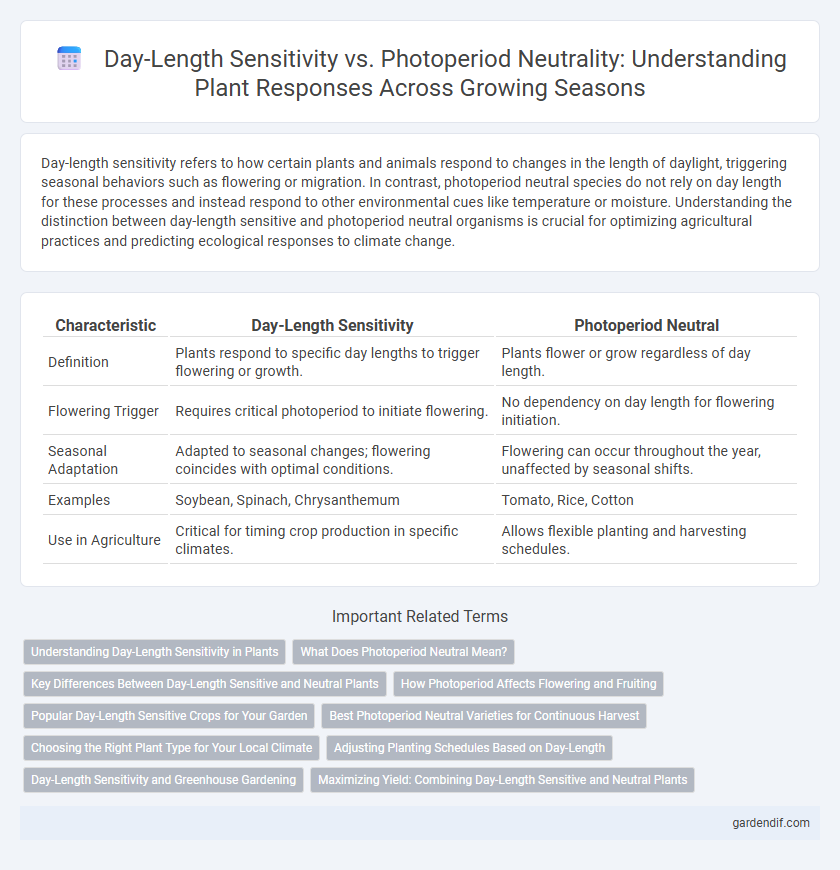
Day-Length Sensitivity vs Photoperiod Neutral Illustration
Day-length sensitivity refers to how certain plants and animals respond to changes in the length of daylight, triggering seasonal behaviors such as flowering or migration. In contrast, photoperiod neutral species do not rely on day length for these processes and instead respond to other environmental cues like temperature or moisture. Understanding the distinction between day-length sensitive and photoperiod neutral organisms is crucial for optimizing agricultural practices and predicting ecological responses to climate change.
Table of Comparison
| Characteristic | Day-Length Sensitivity | Photoperiod Neutral |
|---|---|---|
| Definition | Plants respond to specific day lengths to trigger flowering or growth. | Plants flower or grow regardless of day length. |
| Flowering Trigger | Requires critical photoperiod to initiate flowering. | No dependency on day length for flowering initiation. |
| Seasonal Adaptation | Adapted to seasonal changes; flowering coincides with optimal conditions. | Flowering can occur throughout the year, unaffected by seasonal shifts. |
| Examples | Soybean, Spinach, Chrysanthemum | Tomato, Rice, Cotton |
| Use in Agriculture | Critical for timing crop production in specific climates. | Allows flexible planting and harvesting schedules. |
Understanding Day-Length Sensitivity in Plants
Day-length sensitivity in plants refers to their physiological response to the length of daylight, influencing flowering and growth cycles. Photoperiod-sensitive plants require specific light durations to trigger developmental stages, whereas photoperiod-neutral plants flower regardless of day length. Understanding these mechanisms helps optimize agricultural practices by aligning planting schedules with seasonal light variations.
What Does Photoperiod Neutral Mean?
Photoperiod neutral plants do not rely on changes in day length to trigger flowering, allowing them to bloom regardless of seasonal variations. This characteristic enables adaptable growth cycles in diverse environmental conditions, optimizing yield throughout the year. Understanding photoperiod neutrality is essential for selecting crops suited for continuous cultivation across regions with fluctuating daylight hours.
Key Differences Between Day-Length Sensitive and Neutral Plants
Day-length sensitive plants rely on specific photoperiods to initiate flowering, responding to changes in light duration to regulate their growth cycles. In contrast, photoperiod neutral plants flower independently of day length, primarily influenced by other factors such as temperature or age. This fundamental difference affects crop planning and agricultural productivity, especially in regions with varying seasonal daylight patterns.
How Photoperiod Affects Flowering and Fruiting
Photoperiod sensitivity determines a plant's flowering and fruiting schedule by responding to the length of day and night, triggering physiological changes when specific light durations are met. Day-Length Sensitive plants, such as short-day and long-day varieties, initiate flowering only under particular photoperiods, aligning reproductive phases with optimal seasonal conditions. In contrast, photoperiod neutral plants flower and fruit regardless of day length, relying instead on other environmental cues like temperature and maturity.
Popular Day-Length Sensitive Crops for Your Garden
Day-length sensitive crops such as spinach, lettuce, and soybeans rely on specific photoperiods to trigger flowering and growth cycles, making them crucial for gardeners to plant according to seasonal daylight variations. These crops respond to either long-day or short-day lengths, ensuring optimal yield when the natural light aligns with their genetic photoperiod requirements. Understanding the photoperiodic nature of these popular vegetables helps gardeners optimize planting schedules and improve harvest efficiency.
Best Photoperiod Neutral Varieties for Continuous Harvest
Photoperiod neutral varieties, such as Cherry Tomatoes and certain strains of Lettuce, flower independently of day length, enabling continuous harvest throughout varying seasons. These varieties do not rely on specific light durations, making them ideal for growers seeking steady production without seasonal interruptions. Choosing photoperiod neutral crops maximizes yield consistency in controlled environments and diverse geographical locations.
Choosing the Right Plant Type for Your Local Climate
Day-length sensitivity in plants determines their flowering and growth cycles based on the duration of daylight, making it crucial to select varieties that align with your local photoperiod conditions. Photoperiod neutral plants, unaffected by day length, offer flexibility and consistent performance across varying seasons and latitudes. Choosing the right plant type according to local climate and daylight patterns maximizes yield, ensures healthy development, and reduces stress related to inappropriate growth triggers.
Adjusting Planting Schedules Based on Day-Length
Day-length sensitivity in plants dictates flowering time based on photoperiod, requiring careful adjustment of planting schedules to match seasonal light variations for optimal growth. Photoperiod neutral plants exhibit consistent development regardless of day length, allowing more flexible planting windows. Understanding these differences enables growers to optimize yield by synchronizing crop cycles with environmental light conditions.
Day-Length Sensitivity and Greenhouse Gardening
Day-length sensitivity in plants is a critical factor for greenhouse gardening, as these plants rely on specific light durations to initiate flowering or other growth phases. Managing artificial lighting schedules allows growers to simulate natural photoperiods, optimizing plant development and yield. Understanding the interaction between day-length sensitivity and controlled environments enhances crop production efficiency in greenhouse settings.
Maximizing Yield: Combining Day-Length Sensitive and Neutral Plants
Maximizing crop yield involves strategically combining day-length sensitive and photoperiod neutral plants to optimize growth cycles across varying seasonal daylight hours. Day-length sensitive plants adjust their flowering in response to photoperiod changes, while photoperiod neutral plants grow independently of day length, offering flexibility in planting schedules. Integrating both types allows farmers to extend harvest periods, improve resource use efficiency, and increase overall productivity in diverse environmental conditions.
Day-Length Sensitivity vs Photoperiod Neutral Infographic

 gardendif.com
gardendif.com